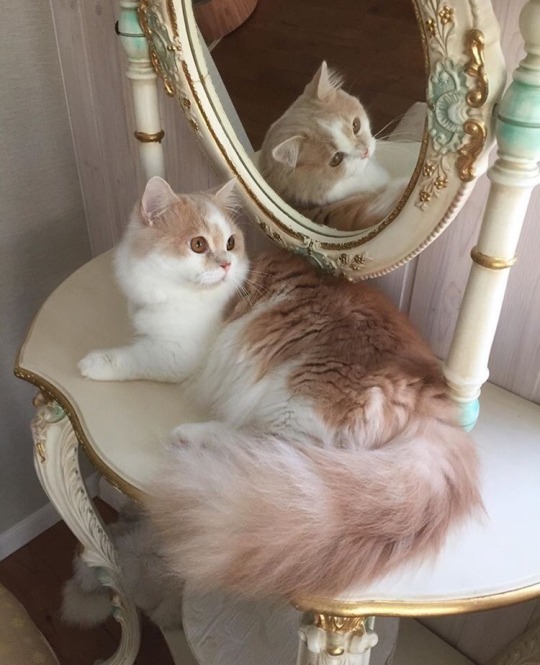This is actually a private account where I'm going to put things about magick that I need to learn.
Don't wanna be here? Send us removal request.
Text
Once I wrote a play that got quickly produced. I was so proud of it. One of its main themes dealt with whether it’s better to take control of a no way out situation and kill yourself or let the situation kill you (doing vs allowing harm). I never thought I would feel like I was in such a similar situation- unless you would count previous suicidal thoughts. I mean, there’s no asteroid hurtling towards me, but everything that’s going on in the world right now shortens our lives significantly every day. There’s nothing I can do to stop that for the world, but can I do it selfishly just for me?
0 notes
Text
Sad when you’ve got suicidal thoughts, but there’s no point in acting on them now ‘cause the world is ending and we’re all gonna die. :)
0 notes
Photo
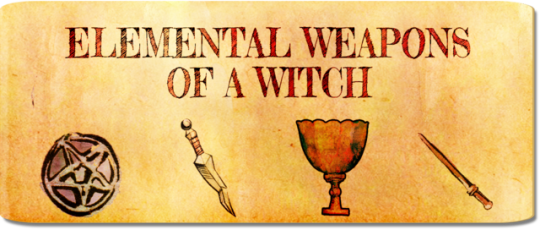
Witches use a variety of tools. The most common are the four weapons. They’re associated with the elements and represent aspects of a witch’s skill.
These are the chalice, athame, wand, and pentacle.
These tools correspond to the four elements - Water, Air, Fire, and Earth. They’re used by the witch to shape reality. Witches use them in many different workings.
Separate traditions associate them with the elements in unique ways. Some switching occurs for the attributions of the wand and athame. Here, we’ll be associating the athame with Air. This is the most common correspondence for it. You can learn more about other associations from those who use them.
These tools (and their elemental attributions) are only symbols. They carry no power in and of themselves. An athame is just a small knife. A chalice is merely a drinking vessel. They are powerless without the Will of a witch. The witch must imbue them with meaning and turn them into conduits for higher forces.
These weapons are not required for effective witchcraft. Yet, they can be helpful in maintaining focus and bypassing the psychic censor. (More on the Psychic Censor here.)
The Weapons are potent symbols for the four elements, parts of a witch’s being, and other concepts.
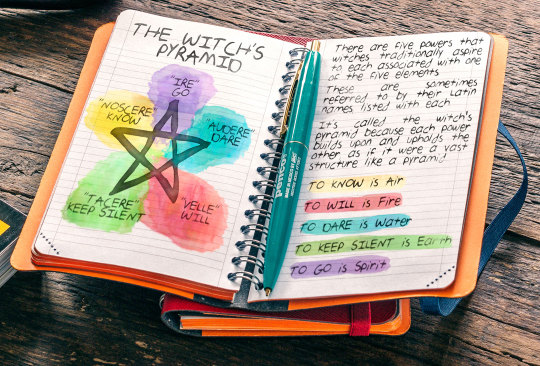
The Witch’s Pyramid (explained above) contains useful concepts. It helps to encourage our self-development and magical understanding. These are a series of loose goals that many witches hope to embody.
Fourfold concepts exist throughout the Western Magical Tradition. The elements tend to correspond well with other fourfold systems. Many Hermetic scholars connect the four elements to concepts within the Hermetic Qabalah, too.
It’s hard to pinpoint the origin of the association between the elements and these tools. The Hermetic Order of the Golden Dawn popularized the idea. So, the weapons have their roots in ceremonial magick. Aleister Crowley, was very fond of these concepts. He wrote about them in “Magick in Theory and Practice”.
Gerald Gardner, a student of Crowley’s, spread the concept amongst witches. Gardner founded Wicca and spearheaded the revival of witchcraft along with it. With that came the emphasis on elemental weapons in witchcraft.
These particular correspondences were, before, rare amongst witches. Historically, witches didn’t use them often, but people like Crowley and the Golden Dawn did.
This is often done in the context of ritual, but you can use them for improvised magick, too. The point is to connect with them, and allow them to connect to the force of the elements themselves. Thus, the tools act as “portals” to the power of the elements.

The Wand
My tradition and practices associate it with Fire. Some associate it with Air, but you will have to read about that elsewhere from someone who does!
Almost everyone associates wands with magick! Wands are a conduit for your own volition. They’re very active tools! Fire is associated with the witch’s Will, hence wands corresponding to it.
Standard wands are as long as the witch’s arm from elbow to fingertips. Wands of this length are practical: easy to brandish and wield. Traditional materials for wand-making vary. Metal, or a symbolic type of wood is often used (and sometimes both). It is common to use wood from a fruit-bearing tree, like apple or almond.
Friends of mine have made their own wands! Often, gathering wood for a wand is a ritual in and of itself. Witches are typically careful to avoid undue harm to the tree.
There are quite a few rituals for gathering wand wood, from different traditions. You can find metal wands in specialty shops. I’ve noticed many metal wands tend to be copper. Copper is conductive, so this is probably chosen as a symbol for the flow of power.
In some traditions, the wand is actually a large staff. These always seemed somewhat impractical to me. They are also much more difficult to get, make, or wield. Still, a lot of ceremonial rituals include them. Many practitioners are indeed comfortable using them.
So, how are wands used? You can use a wand to direct the flow of energy. It can be useful to visualize power coalescing at the tip of your wand. Then, resolutely point it at an object. Picture the power flowing from the wand to enchant the object. I used to use my wand to direct power to craft a subtle boundary, like a magick circle.
The Athame
As mentioned, this is sometimes associated with Fire, but I associate it with Air! These days, the word “athame” usually refers to a knife used in ritual and witchery.
Knives can be dangerous. I associate them with Air, the element of intellect. Why? Like a knife, the intellect is a penetrating force. It is capable of harming or helping. This dual nature is an excellent symbol for the often shifting intellect.
In Wicca and some other traditions, the athame is a double-edged knife. Most often, it has a black handle. The word athame itself appears in medieval grimoires to refer to a ritual blade.
Gerald Gardner popularized the term among the witchcraft community. He had probably read the grimoires that use the term, and chose it as a word for the ritual knife in his tradition.
Despite that, the word has now come to mean a magical dagger. Wicca definitely popularized the term. Even non-Wiccan witches often refer to their dagger as an athame, though.
Sometimes, practitioners will instead refer the knife as an “air dagger.” The Hermetic Order of the Golden Dawn prescribes a complex ritual for creating one. They do this by imbuing an ordinary knife with power. Similar rituals exist for empowering the other weapons, too.
Older ceremonial traditions prefer to use a sword or larger knife. As with the staff, those are impractical for many of us. Witches in particular often seem to prefer the dagger to the sword. This owes to Gardner’s influence and his lore surrounding athames. It is also, of course, an issue of practicality.
Chalice
The chalice or cup is a vessel. Since a cup holds liquid, it is easy to associate with Water. It is also a receptacle, which mirrors the passive yet powerful nature of human emotions.
External sources can cause drastic emotional changes. This is analogous to a cup receiving liquid. We, as human beings, are chalices in a way, and our emotions are the water. We hold our emotions, yet they ebb, bubble, and flow within us.
Some traditions use a cauldron, instead. Cauldrons in some ways may be less practical. But, they’re quite useful for creating a large quantities. A cauldron is best used in situations where a large amount of liquid is necessary.
Many pagan witches associate the chalice with Cerridwin’s cauldron of wisdom. Even non-magical Christian traditions use chalices in rituals. Some associate them with the Holy Grail and the story of Parsifal. Some scholars believe that the Grail story is a Christianized version of a pagan legend.
Chalices can hold wine, water, grape juice, or anything you like. In ceremonial magic, they often hold blessed wine. This practice has also become common among witches. They should be regularly cleaned, though!
They can also hold offerings to spirits, potions, or other magical liquids. It can also be anything that holds water. It could even be a drinking horn or seashell! Many witches will find a nice goblet or wine glass and consecrate it to act as the elemental weapons. That’s what I did, myself!
Pentacle
The pentacle is usually a flat disk inscribed with a pentagram. A pentagram represents the four elements (as well as unifying Spirit). It represents all Earthly elements and Earthly life as a whole. In many traditions, Earth is the “lowest” element.
This isn’t bad - it means the Earth is a receptive element that the rest flow into. A pentagram, then, represents the combined force of all elements. So, many associate it with the melange we call Earth. Carving the pentagram into a clay or wooden disk solidifies the connection to Earth.
For many witches, the pentacle is a flat disk made of preferred material. In ceremonial magick it is sometimes called a panticle. In that case, it sometimes depicts more than a pentagram. Some practitioners will design their own ornate panticles with their own symbols. This is common in Thelema and the A.’.A.’.
You can make a pentacle from many materials! These include stone, metal, wood, etc. Many ceremonial magicians carve them from wax. Witches should do that more often! It’s fun, and easy, but not as common. I’m not sure why! It’s a great way to make a pentacle or panticle.
These are easy to make with a bit of clay or some wood, and it’s pretty fun to do. I made one back in college using the college’s kiln and supplies!
789 notes
·
View notes
Text
DIY: Brews and Potions

Witches standing over an open fire while stirring up potions in a cauldron is one of the many romanticized views of witchcraft. Today, witches brew many things for love, luck, health, wealth, and etc. Potions are a widely regarded instrument for witches. Potions are simply liquid spells that can be taken internally or applied externally to the body. Teas, enchanted perfumes, tinctures, and washes are the many forms these spells can come in. Some are used for healing, others are used in ritual or magickal work.
Kitchen Herbs and Common plants for Brews
Back in the day, homemade teas and salves were the only medicine available. Using these things today is still very popular and a holistic approach to health that treats the mind, body, and soul together. What you use does not have to be expensive, it can come from your back yard or your home. Many of what you already have you can use to make tinctures, teas, and decoctions. Also, syrups, tonics, waters, and vinegars. If you work with the herbs you have at home already on hand, you will be able to create your own remedy with a distinct local flavor.
The Power Behind the Plants
It is believed that many spiritual forces animate the world; called animism. When working with a plant or crystal, or performing a spell or ritual at a specific place, witches work with the spirits behind those plants or crystals, and call upon the spirit of that location to help them in their work. There is a special partnership and alliance between the witch and spirit, manifesting in forms of animals (familiars) or in the form of other plants, crystals, and locations. Over time, working with these spirits on various projects will deepen the relationship and the witch will gain information on magical associations, properties, and lore. These things often come through dreams, inspirations, or visions. The spirit will gain energy, attention, and physical shelter as animals or plants or crystals carried as a talisman.
Keep reading
28K notes
·
View notes
Text
Crystal Terminology
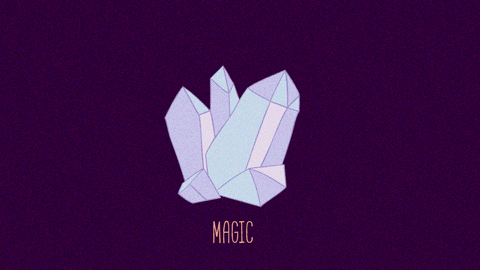
Below is a list of helpful terms to know when working with gems and minerals. It includes terminology on various crystal shapes and forms. Terms specific to mineral shapes have “(form)” next to them for ease of reference.
Abundance (form): An abundance crystal consists of one long quartz crystal with many small crystals clustered around its base. Its function is to attract wealth and abundance.
Adamantine Luster: A particularly brilliant shine as shown by a specimen such as a diamond.
Amorphous (form): Amorphous crystals, such as obsidian, have no particular shape. Energy flows rapidly through and amorphous crystal as it has no rigid internal organization.
Aura: The subtle bio-magnetic sheath that surrounds the physical body, providing a protective zone that extends for about 18 inches to 3 feet from the body and contains information about a person’s physical, mental, emotional, and spiritual state of being.
Aura Crystal: A crystal specimen, usually of the quartz variety, that has been coated with metal (i.e. gold, titanium) in a vacuum chamber resulting in an iridescent sheen.
Ball (form): Balls are usually shaped from a larger piece of crystal and may have planes or flaws within them. They emit energy in all directions equally.
Barnacle (form): A barnacle crystal has many small crystals covering a larger crystal.
Bridge (form): A bridge crystal grows out of another larger crystal. It assists in bridging gaps and bringing things together.
Carat: The standard measure of weight for precious stones and metals. A carat is equal to 0.007 oz (0.2g).
Cathedral Quartz (form): Cathedral quartz may appear to be composed of several convoluted pieces, but these are in fact all part of the main crystal which has multiple terminations with at least one point at the apex.
Channeler (form): A channeling crystal has a 7 sided facet at the front of the termination and a triangular face on the opposite side. It channels healing energy or information from higher sources.
Cleavage: The way a mineral or rock breaks along a certain plane, or in a certain direction.
Cluster (form): A cluster has many points bedded, but not necessarily fixed, into a base. The crystals may be small or large.
Companion (form): A companion crystal has two crystals entwined and partly growing in each other, or a small crystal that grows out of the main crystal.
Cross (form): A cross formation has one crystal at right angles to another, usually larger crystal.
Crystal: A naturally occurring substance whose atoms are arranged in a regular manner.
Crystal System: The systems in which crystals are grouped based on their symmetry. There are 6 crystal systems: cubic, monoclinic, triclinic, trigonal/hexagonal, orthorhombic, and tetragonal.
Diamond Window (form): Flat faces at the top of crystals are called windows. A diamond window is large and connected to the apex and the base.
Double Terminated (form): A crystal with two naturally faceted ends.
Dull Luster: A shine that reflects very little.
Earthy Luster: A non-reflective mineral luster.
Egg (form): A crystal cut in the shape of an egg.
Elestial (form): An elestial has many natural terminations and folds over a multilayered crystal.
Etched (form): An etched crystal that looks as though hieroglyphs or cuneiform writing has been inscribed on its faces.
Faces: The External flat surface that make up a crystal’s shape.
Fault Line: An inner flaw or break in a crystal that refracts light and appears to divide the crystal into sections.
Fluorescence: The optical effect whereby a mineral appears a different color in ultraviolet light than in ordinary daylight.
Fracture: The distinctive way a mineral breaks.
Friable: Minerals that easily crumble are referred to as friable.
Gemstone: A mineral, usually crystal-like, which is valued for its color, rarity, and hardness.
Generator (form): A generator crystal has six facets meeting equally in a sharp point.
Geode (form): A geode is contained within an outer form. When opened, it is hollow with many crystals pointing inward.
Geologist: A scientist who studies the Earth and its structure and composition.
Gridding: The placing of crystals around a building, person, or room for protection or enhancement energies.
Habit: The general shape of a mineral.
Inclusion: Any material that is trapped inside a mineral during its formation, often producing a rainbow.
Iridescence: A play of colors that looks like oil on water that occurs when light reflects off internal elements of a rock or mineral.
Layered (form): Plate-like crystals such as lepidolite are referred to as layered.
Luster: The way in which light reflects of the surface of a mineral.
Manifestation (form): One or more small crystals are totally enclosed by a larger crystal.
Matrix: The bedrock on which crystals are formed.
Metallic Luster: A shine like that of polished metal.
Mineral: A naturally occurring solid with specific characteristics, such as a particular chemical composition and crystal shape.
Mineralogist: A scientist who studies minerals.
Mohs Scale: A scale of hardness used in classifying minerals. It runs from 1 to 10 using a series of reference minerals, and a position on the scale depends on the ability to scratch minerals rated lower.
Occlusion: A mineral deposit within a crystal, which usually shows up as cloudy patches, spots, or a ghostlike image depending on the color of the material.
Opaque: A substance or material that does not let light pass through it.
Ore: A rock or mineral from which metal can be extracted
Phantom (form): A phantom crystal appears ghostlike within the body of a larger crystal.
Pleochroic: In a crystal, appearing to have two or more different colors or shades of color, depending on the angle from which it is viewed.
Point (form): Points may be natural or artificially shaped. A single crystal point has a faceted pointed end and the other end tends to look ragged where it has been separated from a cluster base.
Prism: A solid geometric figure with a set of faces parallel to one another.
Pyramid (form): A crystal with four sides on a base, but the base itself may be squared off if the crystal is natural (i.e. apophyllite) rather than artificially shaped.
Record Keeper (form): A record keeper crystal has clearly etched pyramid shapes on its side or sides.
Resinous Luster: A shine like that of resin.
Scepter Quartz (form): A scepter quartz is a large central rod around one end of which another crystal is formed.
Seer Stone (form): A seer stone is a natural, water polished stone that is cut to reveal an inner world.
Specific Gravity: The ratio of a mineral’s weight compared to the weight of an equal volume of water.
Square (form): A square crystal consolidates energy within its form. It’s useful for anchoring intention and grounding.
Streak: The color of a mineral’s powder. It is less variable than the color of the mineral, so is a more reliable identification tool.
Striation: One of multiple, usually parallel grooves or scratches on a rock surface, produced by abrasion associated with glacial movement, stream flow, a geologic fault, or meteoric impact.
Tabular (form): A tabular crystal has two wide sides resulting in a flat crystal which may be double terminated.
Transmitter (form): A transmitter crystal has two seven-sided facets with two perfect triangles between them.
Tumbled (form): Refers to stones that have been polished in a large drum with grit, resulting in a smooth and often shiny stone.
Vitreous Luster: A shine like that of glass.
Vogal Wand (form): A crystal with specially created, indented facets with specific angles down the sides of a quartz wand.
Wand (form): A crystal in the shape of a wand, either naturally occurring or artificially cut.
(( source | source | source ))
Revised 30 September 2017
13K notes
·
View notes
Text
New Retro Wave MixTape Vol. 3
Previous MixTapes: Vol. 1 | Vol. 2

Starcadian - Midnight Signals (2017)
Bandcamp | Spotify | Youtube
1. Interspace (Music Video) 2. FAMVS 3. Night Games 4. Freak Night 5. Polyanna 6. Black Star (feat. ikonoklasm & HAYLEY) 7. New Cydonia (feat. HAYLEY) (Music Video) 8. The Fury 9. Trapped In America 10. Midnight Signals Overture

NINA - Sleepwalking (2018)
Bandcamp | Spotify | Youtube
1. Beyond Memory (Music Video) 2. Born To Live 3. Sleepwalking 4. It Kills Me 5. Purple Sun 6. Empire Of Love (Music Video) 7. Diamonds In The Rough 8. One Of Us (Music Video) 9. Counting Stars (Music Video) 10. Your Truth 11. 80’s Girl

Night Runner - Thunderbird (2017)
Bandcamp | Spotify | Youtube
1. Pale Rider 2. Red Dawn 3. Desert Eagle 4. Magnum Bullets (feat. Dan Avidan) 5. City Lights 6. Thunderbird 7. Cold Waves 8. Like a Father 9. Contacto Mortal 10. Rawhide 11. Steel Raven 12. Magnum Bullets (Instrumental)
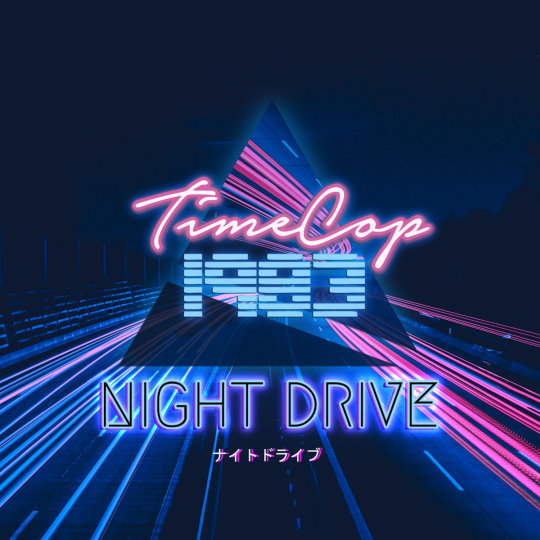
Timecop1983 - Night Drive (2018)
Bandcamp | Spotify | Youtube
1. Static (feat. The Midnight) 2. On the Run 3. Back to You (feat. The Bad Dreamers) (Music Video) 4. Cruise 5. Neon Lights (feat. Josh Dally) 6. Afterglow 7. Too Late (feat. LeBrock) 8. Skylines 9. Tokyo (feat. Kinnie Lane) 10. Nightfall 11. It was only a Dream 12. Girl (feat. SEAWAVES) (Music Video)

Robert Parker - End of The Night (2018)
Bandcamp | Spotify | Youtube
1. End Of The Night (Feat. Doubleboy) (Music Video) 2. Rock N Roll 3. Make Love (feat. Miss K) 4. Maximum Strength 5. Satin Cigarette 6. Silent Kiss (Music Video) 7. All Because of you (Feat. Calderon) 8. Final Moment 9. I Recall (Feat. Preston Knight) 10. Lost Your Mind (Feat. Calderon)

Betamaxx - Archaic Science (2017)
Bandcamp | Spotify | Youtube
1. Abyss 2. Something Else (feat. Hayley Stewart) (Music Video) 3. Causeway 4. Black Pantera (feat. Mike McG) 5. Virtual Fantasies 6. Heart Strings (feat. Rat Rios) 7. Dream Sequence 8. Midnight Prospect 9. Party Favors (feat. Mike McG) 10. Digital Dash 11. Boulevard
16K notes
·
View notes
Text
He's leaving.
It only just hit me today.
At formal, Hey There, Delilah comes on and I'm just standing there watching him. He's literally moving a thousand miles away to make history while I've got at least 2 more years of school to go here.
And he starts talking about how he'll never see some of the people there ever again. And he says a few emotional goodbyes.
I only wish he would have danced with me. He never really did much.
Tomorrow he packs.
It's only been five months.
And we've only got a week left.
2 notes
·
View notes
Text
other witches, dressed in long black robes with blood red fingernails that could cut a man’s throat: i place this curse upon you for all eternity, through the wind and the fire, so mote it be.
me, sitting cross-legged on the floor in a panda onesie: die, bitch
9K notes
·
View notes
Video
552K notes
·
View notes
Text
on this special day i grant you all a wizard’s kiss
11K notes
·
View notes
Text
I feel like the witch equivalent of IT department advice is “Have you tried cleansing and grounding again?”
5K notes
·
View notes
Text
Spell Loopholes
Wording a spell correctly is extremely important! We’ve all heard the stories of someone who cast a spell and technically had it come true, but in a way that wasn’t what they actually wanted at all! Here’s a list of common “loopholes” spells will take to get the job done, and how to make sure you get what you want!
🕯Taking its time- “I want money,” you tell the Universe, hoping to get some help with rent. Well, rent comes and there’s no extra cash in sight! Then, two weeks later, a surprise wad of cash all but lands in your lap. The spell came true, but not in time for when it mattered. This is easily fixed by adding “…by the end of the month,” or specifying what the money is for, which in this case was this month’s rent.
🕯No help needed- “I want money,” you say again. Magic will often take the path of least resistance, so if you’ve already got a paycheck on the way, the spell might not do much besides make sure it doesn’t get lost. There. Money. It can be good to specify that you want your spell to work in addition to everything you’re already doing!
🕯 Bare minimum- This time from your money spell, it arrives on time from an unexpected source! But it’s a quarter you found on the ground. Maybe three quarters. Not much help! If your intent would require the money to be close to a certain amount or any other specific like that, let it be known! The universe isn’t there to make assumptions.
🕯 For the worst- Let’s say you have two friends that have been flirting, so you cast a nice little spell to let any mutual interest between them blossom into a relationship and save them some trouble. It happens, but it turns out they do NOT work well with each other. They are interested in each other, but argue constantly and bring out the worst in each other. The relationship is hurting them both. You had the absolute best of intentions, but there was no way of knowing that would happen! This is why a lot of witches include the phrase, “for the highest good” in their spells, as a failsafe for any unexpected pitfalls like this that may be lurking. The universe will see them but doesn’t know to care unless you specify.
🕯Another layer- Once I made a dream bear to bring me more dreams. Well, I had lots more dreams, but couldn’t remember any of them! I didn’t think that was something I needed to specify. Make sure you hit every point you need to be satisfied with a result.
As a general rule, if my spell includes a prayer or petition of any sort, I take a few minutes and comb through it for stuff like this beforehand. What am I specifying? What am I leaving up to interpretation? Could any of that manifest in a way I would be unhappy with? Take a little time before you start casting to smooth out all those wrinkles! Best of wishes!

21K notes
·
View notes
Text
Using Planetary Squares to Create Sigils
Sigils are very, very popular on Tumblr and the Internet lately. They are perfect for witches and magicians living in today’s dynamic world. There is much consternation and perhaps even a bit of debate, though, over what constitutes a sigil and how to use them properly. I personally just define them as any (usually) two-dimensional symbol communicating magical intent, and I’ve talked about my process for making and charging them here. A lot of us have different methods for making sigils, and there’s really no wrong way to do it (provided it works for you), but there do exist some traditional sigilization methods, among which we find the idea of using planetary squares.
This method, popularized by Agrippa, uses a series of number grids associated with each planet. A statement of some sort of magical intent is translated into numbers, and then the numbers are plotted on the grid. A line is then drawn between the numbers in their order within the statement, beginning with a circle to denote a start point, and ending with a perpendicular line across the main one. You’ve probably seen sigils made in this fashion before - the circle at the beginning and perpendicular line at the end make them rather recognizable.
While not all sigils with those features are planetary, they do employ a similar technique to those using the planetary grids, usually a grid setup of some sort. Of note, many technowitches will use keypads and keyboards as grids in making sigils. Here, though, I’ll describe what’s (mostly) the traditional method for making a simple sigil using a planetary grid. It’s pretty far beyond the scope of this article to include all the grids, but resources for them can be found in various places online, including this site.
Lets just here, as an example, focus on the grid for Venus, which is shown below.

Suppose you’re a witch and would like to create a sigil using it to help a friend find love, or to bring love of some sort into your own life, strengthen an existing relationship, or just invoke the concept of love for some reason in general. Venus is an ideal celestial sphere to work with for this purpose, as most people know, given that Venus is not only named for a goddess of love, but also associated with love in astrology. Venus is associated with other matters, too, such as creativity, fertility, and art, though, so we want to be specific. We could, in theory, just use the glyph, hexagram, or other symbol of Venus for this, but suppose your friend (who has bad luck in love, and needs help with it) wants a custom sigil specifically. It’s quite easy to do.
Like with most sigils, you begin by summing up your intent. Were I doing this for a specific, actual situation and not as an example, I might spend a long time deciding on the correct choice of word or words to sum up the goal of the sigil, but for the purposes of this example, we’ll just use the word LOVE itself as our statement of intent. It’s not very specific, but it’s positive, and using it in this fashion will be a great demonstration of this technique. The word LOVE, after all, only has five letters, and works well to sigilize in this fashion. That’s one thing I do want to emphasize before you try this with something more complex - try to reduce your intent to as few letters as possible. This can be done by removing vowels or repeating letters if your statement is complex, but planetary sigils really do work best with as succinct an intent as possible. You’ll soon see why.
We take the word LOVE and transliterate it into numbers using the following table of values. The table has variations, and witches assign numbers to letters in a variety of ways - some might transliterate their intent into Hebrew or Greek letters and use those systems of gematria, for example. This is the most common way that I’ve seen of doing it in English, though. Of note - Dixie Deerman (whose book taught me to do this back in the day) actually includes a & symbol at the end, equal to 900, and uses that to connect words if necessary. I’ve never been much for that, but some might find it useful, so I mention it. It’s in the image below.

For LOVE, it gets transliterated into five numbers, which are, in order, 30, 60, 400, and 5. This can then be plotted on the Venus square using the method described above, beginning with the first number (30) and ended with the 5. But wait! If you actually look at the Venus square, it doesn’t quite go as high as 400, does it? It doesn’t even go up to 60. So, how do we include those numbers (representing the letters O and V) in the sigil? Well, simply divide them by 10! Instead of plotting straight up 30, 60, 400, and 5 on the grid, we’re plotting 30, 6, 40, and 5. This is how it is commonly done, and, in my experience, it works quite well.
Below is the finished LOVE sigil plotted on the Venus grid. Notice how the first number is circled, to designate where the sigil begins, and the last one is marked with a perpendicular line. Feel free to use this yourself if you want (and feel like doing love magick!), but I do encourage everyone to experiment and make their own for whatever purposes they favor.

Sigils made in this fashion on planetary grids can be used without the grid, naturally. If I were wanting to use the one above as a bit of gesture magick by tracing it in the air, or perhaps just sketch it on a piece of paper for a quick boost, I’d do so without drawing the full grid - just the lines themselves. The grid is implied. When creating the grid on paper in preparation for creating a sigil, though, it’s traditional to draw the lines, and then jump around the grid, filling in the numbers in order. I personally make most of my planetary sigils digitally in Photoshop, but some witches will have all the grids in their grimoire and use tracing paper over them to create the sigils. There’s a lot of methods for making a planetary sigil physically or digitally, so practice, and see what works for you.
Color can play a role in any sigil you create, too. If anything peeves me in the magical community these days, it would be that so few witches realize you can use colorful sigils. I just feel that people miss out when they don’t explore that, and it can be a lot of fun! With planetary sigils, each planet is associated with several colors traditionally (as an example, Venus has an association with both pink and emerald green), and you yourself might have color associations on your own for the planets or the intent of your sigil that can be used. You’ll note above that I’ve tinted the lines of the sigil itself a nice Venusian green, and were I casting the sigil, I’d do it with green ink if possible, or just visualize it in green. In fact, were I to suggest someone use this sigil (or were I using it myself), it might end up looking something like this:

The usual “rules” (as in, whatever you usually get results doing) as far as charging and preparing mentally to use a sigil apply with planetary sigils, as well. If you’ve read my article on charging sigils, you know that I personally know some folks who don’t “charge” sigils formally, yet still get good results. A lot of them work with planetary sigils, and the general consensus between us (having discussed this) is that, for some people, the very process (which you now see is quite involved) for creating these sigils can be sufficient to charge them. Whatever works for you is fine, but definitely experiment a bit.
I hope this article on planetary squares and sigilization was useful or entertaining for you, and that you create wonderful magick, regardless of how you do it! Planetary squares used in sigilization are a great way to get started working with celestial forces in specific ways, and they’re ideal for witches who’re on a budget or trying to keep things low-key, as they, like most sigils, require essentially nothing but paper and pen to create. If you like my work, consider donating or purchasing a divination reading in my shop, and if you have an questions, feel free to contact me.
1K notes
·
View notes
Text
Witch Tip: making your sigil look better
Construct your sigils inside a shape. Make this outer shape a different color or thickness to differentiate the sigil from the outline. Develop a Key for deciding which shape to use. For example: a circle = neutral/all-purpose, triangle = protection or ward, square = enhance ability (for motivation or creativity), rectangle = spell-work (for sealing a bottle or charging a spell), star = curse, heart = love, clover = luck Adapt your sigil shapes to whatever you want!
2K notes
·
View notes
Photo

There must be countless ways to design sigils, and many witches surely have their own signature methods. I want to share these three methods with you so that you can more easily decide for yourself what method best suits your style - or even so that you can just change methods on a whim when an otherwise unconventional method is more convenient.
If you are a beginner witch with no idea where to start or what materials to use, sigils are easily one of the best things for you to start with. Pretty well all you need is a little quiet time, a pen, and paper.
Keep reading
809 notes
·
View notes
Photo






There’s been a lot of talk of sigils lately but without any step-by-step guide on how to use them. So I’ve broken this down as simply as a can for those of you who are interested but don’t understand the resources you’ve been given.
The bottom five images are transparent and free to use.
* For Good Health: To my knowledge it doesn’t matter if you keep multiple word sigils separate or over-lapping, so do whatever you have to with the space you have.
9K notes
·
View notes
